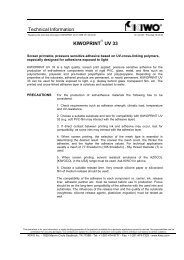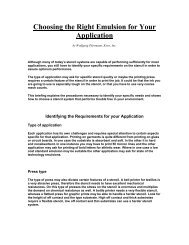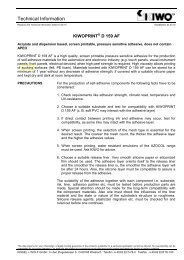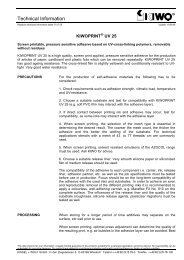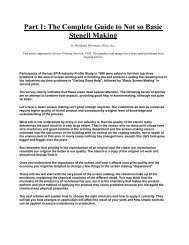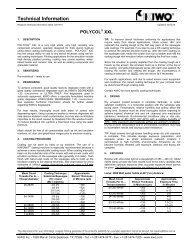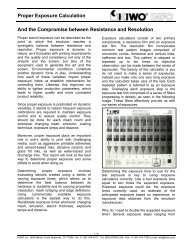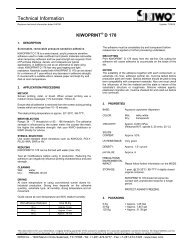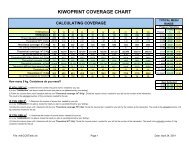Create successful ePaper yourself
Turn your PDF publications into a flip-book with our unique Google optimized e-Paper software.
Technical InformationReplaces Technical Information dated 09/20/00 Update: 02/18/10<strong>KIWO</strong>COL ® <strong>POLY</strong>-<strong>PLUS</strong> <strong>SWR</strong>1. DESCRIPTION<strong>KIWO</strong>COL ® <strong>POLY</strong>-<strong>PLUS</strong> <strong>SWR</strong> is a low to medium viscosity diazophotopolymeremulsion specifically designed for high quality textileand graphic printing. It is solvent and water-resistant and offers fastemulsion build-up while maintaining excellent resolution and meshbridging. High resistance to solvents and moisture makes a verydurable stencil that is suitable for long runs on a variety of substrates.2. SENSITIZINGSensitize with Sensitizer #1 (supplied). Fill sensitizer bottle accordingto the directions on the diazo bottles label - preferably using warmdistilled water. Diazo sensitizer dissolves easier in warm water anddistilled water assures no potentially detrimental heavy metalcontamination occurs. Cover lid with rag or paper towel to protecthands from leakage, then shake bottle until diazo is fully dissolved.Allow the mixed emulsion to de-bubble after sensitizing for two hours.Store emulsion in a cool (68°F / 20°C) dark place.3. DEGREASINGTo achieve consistent, good quality stencils, degrease mesh with agood quality commercial degreaser such as <strong>KIWO</strong>’s DEGREASER1:20 CONCENTRATE or ULTRA PREP. For degreasers used inautomatic equipment, <strong>KIWO</strong> offers a specially formulated machinegrade degreaser <strong>KIWO</strong>CLEAN DEGREASER 1:40 CONCENTRATE.See separate Technical Information sheets for further detailsregarding <strong>KIWO</strong>’s degreasers.For best results, thoroughly brush both sides of screen withdegreasing agent. Using a pressure washer to remove degreaser willhelp remove stubborn mesh contaminates, but may also re-introduceimpurities to the mesh caused by blowback from the washout booth.To reduce blowback risk, perform a final flood rinse using low waterpressure.Mesh should be free of all contaminates such as ink and emulsionresidues, oil, dust, and ghost/haze images prior to emulsion coating.4. COATING PROCEDURECoating can be done manually or by machine. The use of a<strong>KIWO</strong>MAT ® coating machine is especially recommended because itachieves a more reproducible coating result. When coating manually,begin on the substrate side of the screen with wet-on-wet coats untilemulsion surfaces on the squeegee side (generally 2-3 coats). Thenfinish with wet-on-wet coats on the squeegee side to build up theemulsion coating to the desired thickness (generally 1-3 coats)depending on the printing requirements.<strong>KIWO</strong>COL ® <strong>POLY</strong>-<strong>PLUS</strong> <strong>SWR</strong> has excellent coating properties onmesh counts of 40-460 threads per inch (16-185 threads per cm). Forbest printing results, the following coating techniques arerecommended using a round (2 - 2.5 mm) edged coating trough:40-110 tpi (16-43 tpcm): 2-1 wet-on-wet137-260 tpi (54-100 tpcm): 2-2 wet-on-wet305-460 tpi (120-185 tpcm): 2-2 wet-on-wetFor specific applications, and due to varied screen room equipmentand conditions, the correct coating technique for your process mustbe determined through coating tests.Contact <strong>KIWO</strong> for more specific coating techniques.5. DRYINGDry emulsion coated screens in complete darkness, or undersafelight conditions, in a horizontal position with the substrate sidefacing down. Temperature, relative humidity and airflow affect thedrying time. Screens must be dried thoroughly before exposing toachieve highest chemical (ink and ink cleaners) and mechanical(abrasion) resistance. Environmental conditions play a vital role.Temperatures of 86°-104°F (30°-40°C) with a relative humidity of30% - 50% maximum and moderate airflow are optimum conditions.Drying at room temperature and in uncontrolled conditions may leadto inconsistent results and varying screen resistance.TIP: Keep screens and all screen handling areas dry until exposureis complete. This includes storage, exposure preparation, andexposure areas, as photo emulsions reabsorb moisture ifreintroduced to high humidity environments. Emulsions do notbecome humidity resistant until exposure, washout and drying arecomplete.6. EXPOSINGExpose with ultra-violet light at a wavelength of 350 – 420 nm. Metalhalide lamps provide the best results. Due to the many variables thatdetermine optimum exposure time, accurate exposure times cannotbe given. The following examples are offered as a guide only.Lamp: 5000 Watt metal halide at 40” (1m) distance:Mesh Counttpi (tpcm)Mesh ColorCoatingTechnique156-64 (61-64) Yellow 2-2305-34 (120-34) Yellow 2-2Exposure TimeBlue ~ 120 sec.Red ~ 100 sec.Blue ~ 60 sec.Red ~ 60 sec.Correct exposure times for your equipment and mesh selection mustbe determined through exposure tests using an exposure calculatorsuch as the <strong>KIWO</strong> ® ExpoCheck.Under-exposed screens feel slimy on the squeegee side duringdeveloping. At correct exposure time, the screen is not slimy.Overexposure leads to loss of small details. Correctly exposedscreens will withstand high water pressure during washout.Please contact <strong>KIWO</strong> if you have further questions regardingexposure time.7. DEVELOPING / WASHOUTDevelop the screen using full pressure tap water and a mediumspray pattern. Adjust the water temperature to lukewarm or slightlycolder. Rinse thoroughly from both sides of the screen. Vacuum offany excess water or blot it off with blank newsprint paper. This willavoid runs or scum from under-exposure in the open areas.This data sheet is for your information, a legally binding guarantee of the product's suitability for a peculiar application cannot be derived. No responsibilities can beundertaken for occurring damages. Our products are subject to a continuous production and quality control and leave our factory in perfect condition.<strong>KIWO</strong> Inc. - 1929 Marvin Circle Seabrook, TX 77586 - Tel: +1-281-474-9777 - Fax: +1-281-474-7325 - www.kiwo.com
Technical Information<strong>KIWO</strong>COL ® <strong>POLY</strong>-<strong>PLUS</strong> <strong>SWR</strong>Page 2 of 2Update: 02/18/108. POST-EXPOSUREPost-exposing the screen after developing and drying is not veryeffective. To improve the resistance 10-15% the post-exposure timeneeds to be four times the original exposure time. Exposing thescreen fully with the primary exposure offers better resistance thanunder exposing initially, then post-exposing to improve resistance.Post exposure is most often used for long printing runs when waterbased and/or abrasive inks are used.9. POST-HARDENING (CHEMICALLY)The emulsion can be chemically post-hardened using one of <strong>KIWO</strong>’sstencil hardeners. Stencil hardeners can be classified as reclaimableor un-reclaimable.If reclaiming ability is desired, use <strong>KIWO</strong> HARDENER WR orHARDENER HP.If a permanent un-reclaimable stencil is desired, for example whencataloging screens for future use, or when aggressive inks are usedfor very large print runs, use <strong>KIWO</strong> HARDENER K. See separateTechnical Information sheets for further details regarding <strong>KIWO</strong>’sstencil hardeners.effective ink ghost removal, HAZE REMOVER can be used inconjunction with <strong>KIWO</strong>CLEAN ® CONCENTRATED INK WASH orULTIMATE INK WASH to re-activate dried HAZE REMOVER.Active components in FAST LIQUID HAZE REMOVER and MEGACLEAN ACTIVE work in approximately five minutes and effectivelyremove both emulsion haze and ink ghost simultaneously. Seeseparate Technical Information sheets for further details regarding<strong>KIWO</strong>’s haze removers.Haze removers, like ink washes and stencil removers should beworked into the screen mesh from both sides of the screen beforeremoving for maximum effectiveness.13. PHYSICAL PROPERTIESViscosity:Viscosity sensitized:approx.: 10,000 mPasapprox.: 5,000 mPasSolids Content: approx.: 38%Color:Color Sensitized:Storage:light blue or light redlight green or light red1 year at 68°F/20°C10. BLOCKOUT / TOUCH-UPPotlife:4-6 weeks at 68°F/20°CWhen printing with plastisol, UV and solvent-based inks, retouchingand blocking out can be done with <strong>KIWO</strong>’s BLOCKOUT, REDBLOCKOUT or <strong>KIWO</strong>FILLER SR 401 NV. For a water resistancestencil, block out and retouch with <strong>KIWO</strong>FILLER <strong>SWR</strong> 22 or use<strong>KIWO</strong>COL ®<strong>POLY</strong>-<strong>PLUS</strong> <strong>SWR</strong> (dry thoroughly and re-exposecompletely prior to using stencil hardeners). See separate TechnicalInformation sheets for further details regarding <strong>KIWO</strong>’s blockouts.11. RECLAIMING<strong>KIWO</strong>COL ®<strong>POLY</strong>-<strong>PLUS</strong> <strong>SWR</strong> can be reclaimed with <strong>KIWO</strong>’sSTENCIL REMOVER 1:20 CONCENTRATE. Before reclaiming, ensurethe screen is completely cleaned of ink or ink cleaning chemicalresidues. If water beads up on the stencil, residues are still present.If this is the case, degrease the screen again prior to reclaiming forbest results.For best results, work both sides of the screen i.e. apply stencilremover, brush, and pressure wash both sides of the screen. Afterapplying stencil remover, a short dwell time may be used prior topressure washing to allow more working time for the stencil removerespecially when using coarser meshes and/or thicker stencils.CAUTION: Never allow stencil removers to dry prior to removal, asthe emulsion will become locked into the mesh and virtuallyimpossible to remove.Pre-coated screens: 1-3 weeks in completedarkness at 68°F/20°CFreezing:VOC:TLV:protect against freezingnoneN/AHMIS rating: Health – 1Flammability – 0Reactivity – 014. PACKAGING1 US Quart, 1 US Gallon, 5 US Gallons, 55 US Gallon Drum.15. ADDITIONAL INFORMATIONFor additional product information, please visit our web site atwww.kiwo.com. All products mentioned in this Technical Informationare available through <strong>KIWO</strong> Inc. and its distributor network. Forfurther information contact your authorized <strong>KIWO</strong> distributor or <strong>KIWO</strong>directly.Thank you for choosing <strong>KIWO</strong>.See separate Technical Information sheets for further detailsregarding <strong>KIWO</strong>’s stencil removers.12. HAZE REMOVINGTo remove emulsion haze or ghost images left from the ink, use<strong>KIWO</strong>’s HAZE REMOVER, FAST LIQUID HAZE REMOVER, orMEGA CLEAN ACTIVE.For best results, HAZE REMOVER should be applied to a dryscreen, then allowed to completely dry on the screen. For more




